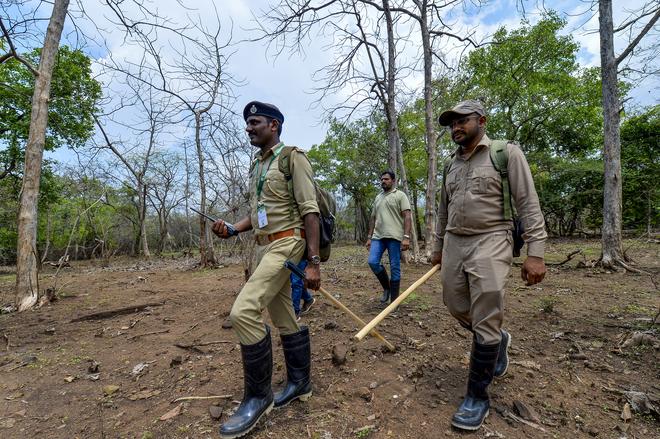An Asiatic Lioness with four cubs at Gir Sanctuary during the 16th Asiatic lion census.
| Photo Credit: Vijay Soneji
India’s lion population, exclusively concentrated in Gujarat, has risen by 32% between 2020 and 2025, with 891 lions reported, according to a report from the Gujarat Forest Department released on Wednesday (May 21, 2025). The number of adult females – a proxy for future growth – rose by 27% to 330 individuals.
News in Frames: Tracking the kings

Team in action: Foresters work alongside volunteers in the Gir Sanctuary during field activities
On the watch: Foresters accompany observers to monitor lions.
On the ground: A view of the reception centre of Sinh Sadan, Sasan, Gir Sanctuary, during the Lion Population Estimation, 2025 in Sasan on May 12.
At work: Two forest officials take notes while monitoring lions in the Gir Sanctuary.
Wild family: A lioness with four cubs.
Eyes on nature: Three camera traps deployed in the Gir Sanctuary.
Under lens: Two foresters capture images of a lion.
Keeping a watch: The king surveys his lands in Gir Sanctuary.
Living with nature: A Maldhari from Dudhala Nes with his livestock in the Gir Sanctuary.
In harmony: The Maldharis and their livestock have been coexisting with the lions for long in the sanctuary.
1/3
Though the maximum number of lions – 394 – have been observed in the Gir National Park and Paniya Wildlife Sanctuary, considered the ‘source’ population, the latest survey underlines the continuing trend of lions expanding into more parts of Gujarat. More lions have now been reported outside the core protected zone than inside. This translates to increasing proximity to human settlements and subsequent conflict.
Y.V. Jhala, an expert on lion conservation and formerly with the Wildlife Institute of India (WII), said that while Gujarat continued to be a good model for lion conservation, it was important to create new spaces where lions could live without human contact.
“In theory, Gujarat can host up to 2,000 lions, but that is due to the availability of prey. This is evidenced by the rising number of cattle carcasses. While communities who have been living with lions are tolerant and those who lose their animals are being compensated, there is always a fine balance. For the future, new regions – within or outside Gujarat – are required,” he told The Hindu. The Kuno National Park in Madhya Pradesh, which is home to translocated cheetahs, was originally intended to be a new habitat for lions.

In March, Prime Minister Narendra Modi approved ‘Project Lion,’ a ₹2,900 crore project to improve lion habitat and develop new habitat within Gujarat. The 2025 population estimate includes new satellite populations in Barda Wildlife Sanctuary, Jetpur and adjoining areas, and Babra-Jasdan and adjoining areas, increasing the total number of Asiatic lions in satellite populations to 497 across nine such populations. “For the first time, population in a corridor area has been recorded with a population of 22 individuals,” a press statement from the Gujarat government noted.
The Mityala Wildlife Sanctuary – one of the regions with rising lion numbers – has reported 32 lions, a doubling since 2020.

From 2015 to 2020, the territorial range of the lions extended to 30,000 sq. km, reflecting a 36.4% growth. By 2025, the area reached 35,000 sq. km, registering a 16.67% increase over the 2020 figure. “This progressive expansion demonstrates consistent range growth supported by conservation efforts and natural lion dispersal,” the report notes.
A study in the journal Conservation Biology published in December, which studied the evolution of human-lion dynamics in Gujarat, reported that in recent years, there had been an annual 10% increase in the number of villages reporting livestock attacks, with livestock killed per village increasing by 15% annually. While 61% of those surveyed for the study were “tolerant” of lions, it concluded that only “participatory and profitable land-sharing approaches could sync the well-being of local communities with sustainable carnivore conservation.”
Published – May 21, 2025 02:09 pm IST